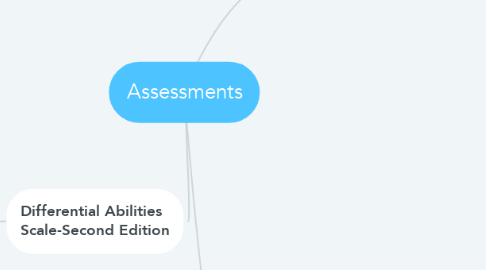
1. Differential Abilities Scale-Second Edition
1.1. Composed of 20 different subsets categorized by the age of the examinee
1.2. Children age 2 years 6 months to 3 years 5 months take the lower Early year subtests
1.3. Children ages 3 years 6 months to 6 years 11 months take the upper Early Years subtests
1.4. Children ages 7 years 0 months to 17 years and 11 months take the School Years subtests
1.5. This test is given in order to measure strengths and weaknesses in the individual subsets or in a combination of subtests.
1.6. Includes a special nonverbal composite that "is used to score the reasoning abilities of individuals whose verbal skills are compromised".
1.7. Identifies the child's general conceptual reasoning abilities.
2. The Universal Nonverbal Intelligence Test
2.1. Measure for children ages 5 years to 17 years 11 months
2.2. Includes 6 subtests which can be given as a standard battery, abbreviated battery, or extended battery (Bracken & McCallum, 1998).
2.2.1. Typically given in the standard battery (4 subtests) and the extended battery (all subtests)
2.2.2. Abbreviated battery consists of 2 subtests given for screening rather than diagnostic purposes.
2.3. "Measures reasoning and memory skills through nonverbal presentation of the subtests" (Overton).
2.4. Subtests in UNIT
2.4.1. Symbolic Memory, Cube Design, Spatial Memory, Analogic Reasoning, Object Memory, Mazes
2.5. Designed to be a fair measure of intellectual ability for students who may have difficulties obtaining accurate estimates of ability in test that use verbal content heavily.
2.5.1. UNIT uses gestures such as "palm rolling" to convey messages during the assessment. "Palm Rolling" gives a message to the student to "continue", "keep going", or "take your turn now".
2.6. Score Interpretation: Very Superior >130 Superior 120-130 High Average 110-120 Average 90-110 Low Average 80-90 Delayed 70-80 Very Delayed <70
3. Vineland Adaptive Behavior Scales, Second Edition (Vineland-II)
3.1. Revision of the original Vineland Social Maturity Scale (Doll, 1935) and the Vineland Adaptive Behavior Scales (Sparrow, Balla, & Cicchetti, 1984).
3.2. Contains additions items at lower levels and stays consistent with the recommendations of the American Association on Mental Deficiency (Sparrow, Cicchetti, & Balla, 2005).
3.3. Scales include: Survey Interview Form, Parent/Caregiver Form, and the Teacher Rating Form
3.3.1. The Parent Form is also available in Spanish
3.3.2. The Interview Form and the Parent Rating Form both assess the same skills. The Parent Form is in a rating scale format.
3.3.3. Survey and Parent Forms: used to obtain information about individuals who are ages 0-90
3.3.4. Teacher Form: designed for students ages 3-21 years 11 months and assesses communication, daily living skills, socialization, motor skills, and optional maladaptive behavior scale

